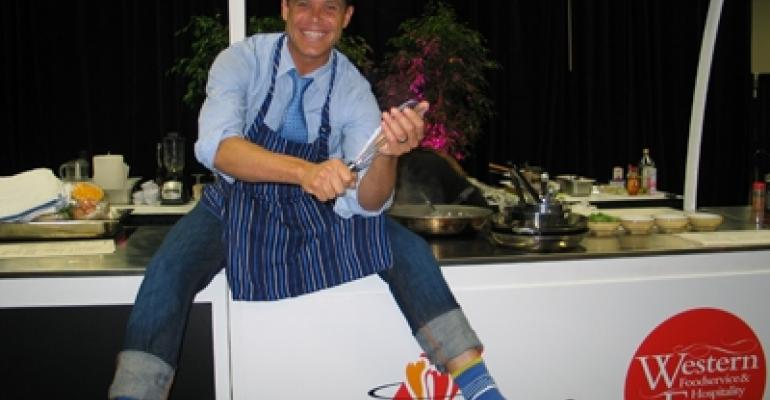Pricing advice, how to manage your restaurant’s digital reputation and being a better leader were key insights at the annual Western Foodservice & Hospitality Expo, a three-day trade show hosted by the California Restaurant Association that ended Tuesday.
Celebrating its 75th anniversary, the show drew thousands of foodservice professionals to the San Diego Convention Center to peruse roughly 650 exhibitors, watch cooking demonstrations, attend educational sessions and get ideas about how to better run their businesses.
For the third consecutive year, the Expo featured the Expo Comida Latina, a trade show featuring Hispanic and Asian foods and beverages.
The show also coincided with the CRA’s annual board meeting, at which Harald Herrmann, chief executive of Yard House restaurants, was named this year’s chairman of the association’s board.
View a slideshow from the show floor
Economy, restaurant business brightening
While the mood was upbeat on the show floor, the topic of higher commodity prices was a recurring theme among speakers at the various educational sessions.
Melissa Wilson, a principal of the research firm Technomic Inc., told attendees at one session that consumers are noticing rising prices in grocery stores more than restaurants, and that there’s room for higher menu pricing, despite the choppy economic environment.
According to Technomic data, 33 percent of consumers said they thought grocery prices are significantly higher, while only 16 percent said the same about restaurant pricing.
And when asked why they thought restaurant prices were going up, consumers blamed the higher cost of gas and ingredients. Only 9 percent said they thought restaurant operators just “wanted to make more money.”
While consumer confidence remains low and Americans continue to be “spooked” by news ranging from rising gas prices to hurricanes along the East Coast, “the worst is over,” Wilson said.
However, the pervasive “deal environment” among restaurants that developed last year has continued, she said. With commodity prices rising, restaurant operators are forced to raise prices.
Wilson noted that consumers appear to be okay with that.
Technomic surveys indicate that consumers missed dining out during the recession, Wilson said.
“They missed being waited on. They missed the ability to take the family out and everyone ordering something different,” she said. “They missed the experience element of dining out, not just the food.”
For restaurant operators, that means improving the customer experience is one thing to focus on post-recession, Wilson said.
Continued from page 1
Managing public perceptions
In another session, chefs and bloggers debated how restaurant operators can deter fake reviews posted on sites such as Yelp.
Darnell Holloway, Yelp’s manager of local business outreach, said the site uses algorithms to filter content based on the posting review and patterns of usage. Reviews that violate the site’s guidelines are removed, while questionable postings are moved to an unfiltered section.
Still, audience members cited examples of Yelp reviews that were clearly fake, such as one from a customer who claimed to have visited a restaurant on a holiday when the business was closed.
Some operators said they try to respond to Yelp reviewers.
Amanda Baumgarten, executive chef of Water Grill restaurant in Los Angeles, said her company watches Yelp reviews. If a customer gives the restaurant less than three stars, the guest is invited back for another meal.
“We use it for constructive criticism,” said Baumgarten.
Others, like Mark Peel, chef and owner of Campanile and The Tar Pit in Los Angeles, said he rarely looks at Yelp.
“I don’t have any strong feeling about how powerful it is or not,” he said.
At a panel hosted by the Foodservice Council for Women, speakers, such as Kat Cole, president of Cinnabon Inc., offered advice for new business owners about leadership and building a path for success.
Among the recommendations:
• Establish your vision and live it. “There are few more expensive issues in business than people feeling lost or confused,” Cole said. “You have to be clear in your vision. Have clarity and provide that for everyone on the team.”
• Make a plan. Write it down and communicate it well, but don’t be afraid to change it.
“If the plan isn’t working, recalibrate. Don’t force it,” Jim Frank, vice president of Marie Callender’s Restaurants, said.
• Put systems in place to execute the plan. “In the absence of alternative information, people will come up with their own stuff,” Cole said.
• Use the power of your brand. By making connections with the community — whether it’s feeding those left homeless after a natural disaster or supporting anti-hunger organizations — your restaurant can change the world for the better, the panel concluded.
Contact Lisa Jennings at [email protected].
Follow her on Twitter: @livetodineout




